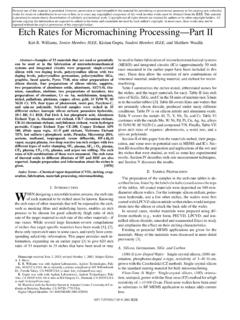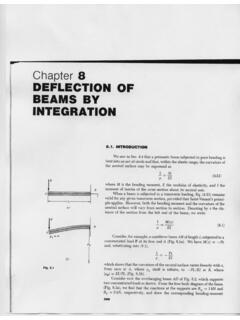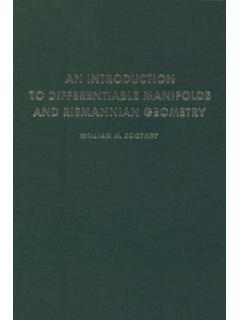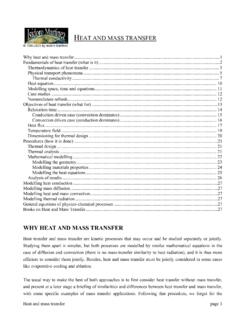Transcription of Introduction to Finite Element Modeling
1 Introduction to Finite Element Modeling Engineering analysis of mechanical systems have been addressed by deriving differential equations relating the variables of through basic physical principles such as equilibrium, conservation of energy, conservation of mass, the laws of thermodynamics, Maxwell's equations and Newton's laws of motion. However, once formulated, solving the resulting mathematical models is often impossible, especially when the resulting models are non-linear partial differential equations. Only very simple problems of regular geometry such as a rectangular of a circle with the simplest boundary conditions were tractable.
2 The Finite Element method (FEM) is the dominant discretization technique in structural mechanics. The basic concept in the physical interpretation of the FEM is the subdivision of the mathematical model into disjoint (non-overlapping) components of simple geometry called Finite elements or elements for short. The response of each Element is expressed in terms of a Finite number of degrees of freedom characterized as the value of an unknown function, or functions, at a set of nodal points. The response of the mathematical model is then considered to be approximated by that of the discrete model obtained by connecting or assembling the collection of all elements.
3 The disconnection-assembly concept occurs naturally when examining many artificial and natural systems. For example, it is easy to visualize an engine, bridge, building, airplane, or skeleton as fabricated from simpler components. Unlike Finite difference models, Finite elements do not overlap in space. Objectives of FEM in this Course Understand the fundamental ideas of the FEM Know the behavior and usage of each type of elements covered in this course Be able to prepare a suitable FE model for structural mechanical analysis problems Can interpret and evaluate the quality of the results (know the physics of the problems) Be aware of the limitations of the FEM (don't misuse the FEM - a numerical tool) Finite Element Analysis A typical Finite Element analysis on a software system requires the following information: 1.
4 Nodal point spatial locations (geometry) 2. Elements connecting the nodal points 3. Mass properties 4. Boundary conditions or restraints 5. Loading or forcing function details 6. Analysis options Because FEM is a discretization method, the number of degrees of freedom of a FEM model is necessarily Finite . They are collected in a column vector called u. This vector is generally called the DOF vector or state vector. The term nodal displacement vector for u is reserved to mechanical applications. FEM Solution Process Procedures 1. Divide structure into pieces (elements with nodes) (discretization/meshing) 2. Connect (assemble) the elements at the nodes to form an approximate system of equations for the whole structure (forming Element matrices) 3.
5 Solve the system of equations involving unknown quantities at the nodes ( , displacements) 4. Calculate desired quantities ( , strains and stresses) at selected elements Basic Theory The way Finite Element analysis obtains the temperatures, stresses, flows, or other desired unknown parameters in the Finite Element model are by minimizing an energy functional. An energy functional consists of all the energies associated with the particular Finite Element model. Based on the law of conservation of energy, the Finite Element energy functional must equal zero. The Finite Element method obtains the correct solution for any Finite Element model by minimizing the energy functional.
6 The minimum of the functional is found by setting the derivative of the functional with respect to the unknown grid point potential for zero. Thus, the basic equation for Finite Element analysis is 0= pF where F is the energy functional and p is the unknown grid point potential (In mechanics, the potential is displacement.) to be calculated. This is based on the principle of virtual work, which states that if a particle is under equilibrium, under a set of a system of forces, then for any displacement, the virtual work is zero. Each Finite Element will have its own unique energy functional. As an example, in stress analysis, the governing equations for a continuous rigid body can be obtained by minimizing the total potential energy of the system.
7 The total potential energy can be expressed as: = qdSdbdVddVTTT 21 where and are the vectors of the stress and strain components at any point, respectively, d is the vector of displacement at any point, b is the vector of body force components per unit volume, and q is the vector of applied surface traction components at any surface point. The volume and surface integrals are defined over the entire region of the structure and that part of its boundary subject to load . The first term on the right hand side of this equation represents the internal strain energy and the second and third terms are, respectively, the potential energy contributions of the body force loads and distributed surface loads.
8 In the Finite Element displacement method, the displacement is assumed to have unknown values only at the nodal points, so that the variation within the Element is described in terms of the nodal values by means of interpolation functions. Thus, within any one Element , d = N u where N is the matrix of interpolation functions termed shape functions and u is the vector of unknown nodal displacements. (u is equivalent to p in the basic equation for Finite Element analysis.) The strains within the Element can be expressed in terms of the Element nodal displacements as = B u where B is the strain displacement matrix. Finally, the stresses may be related to the strains by use of an elasticity matrix ( , Young s modulus) as = E.
9 The total potential energy of the discretized structure will be the sum of the energy contributions of each individual Element . Thus, = ee where e represents the total potential energy of an individual Element . () = = eeqdSNupdVNuudVEBBuTTTTTTTe021. Taking the derivative () = = eeqdSNudVNudVEBBuTTTTe021 one gets the Element equilibrium equation k u f = 0 where +=eqdSNudVNfTT and () =eudVEBBkTT and k is known as the Element stiffness matrix. The physical significance of the vectors u and f varies according to the application being modeled. Application Problem State (DOF) vector d represents Forcing vector f represents Structures and solid mechanics Displacement Mechanical force Heat conduction Temperature Heat flux Acoustic fluid Displacement potential Particle velocity Potential flows Pressure Particle velocity General flows Velocity Fluxes Electrostatics Electric potential Charge density Magnetostatics Magneticpotential Magnetic intensity Discretization Meshing Coarse: Faster computation; not concerned about stress concentrations, singularities, or warping.
10 Not near changes in geometry or displacement constraints or changes in material including thickness. Fine: Best approximation but at the cost of the computation time. Look for disproportionate stress level changes from node to node or plate to plate and large adjacent node displacement differences to determine if need to refine the mesh. Nodes should be defined at locations where changes of geometry or loading occur. Changes in geometry relate to thickness, material and/or curvature. A simple check, if you can, is to decrease the mesh size by 50%, re-run analysis, and compare the change of magnitude of stresses and strains. If there is no significant change, then ok.









